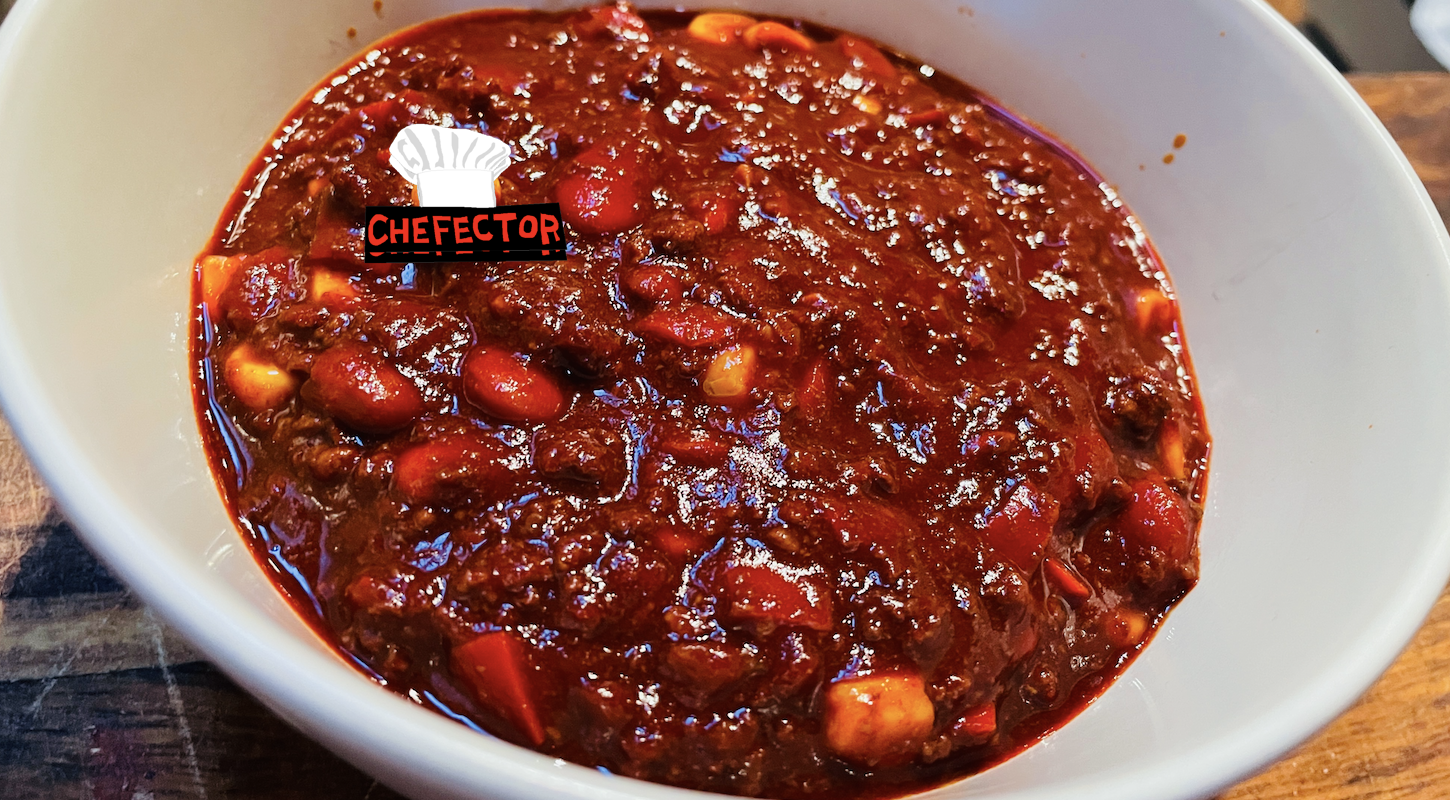Let’s Make The Chili That, Uh, I Made This Week
9:45 AM EDT on October 29, 2022

I'm abundantly on the record regarding chili, for anyone who cares to dig through the internet. At heart chili is simple common-people food, arising from the need to turn what was available into something hearty and nourishing, and you should take this as broad license to accomplish chili by whatever means work for you and result in chili that tastes good to you. Years ago I published a chili recipe on the old website that I regard as a perfectly fine weeknight chili: You could start making it when you got home from work and eat it 90 minutes or so later, and it would be fine, and you would be glad. A while back here on this site I published a recipe for green chicken chili that is also very easy and quick to make and delicious. Chili that is like that is, to me, good chili.
But that is not what I wanted this week! What I wanted this week was to make something as rich with the flavor of actual chili peppers—not powders, and certainly not powders added to tomato products—as I could manage within the constraints of a broadly sane and normal life. I wanted, essentially, chili-pepper gravy that happened to have some stuff suspended in it. That is what I set out to make. The result was fantastic, if also kind of ludicrously painstaking at one point. I recommend you try it! But I will understand if you would rather be fed to piranhas. In any event here is what I did.
Here are some things that you will need. Or anyway here is some stuff that I used.
I used, uh, like, a ton of dried chili peppers. I dunno man! I stood in front of the rack of bags of dried peppers at the international supermarket and my eyes rolled back in my head and the next thing I knew my kitchen counter was absolutely covered in plastic bags of dried peppers. The idea that I could describe any specific volume or quantity of peppers here is preposterous. It was a lot. To ballpark it, I have a 10-quart potbellied, uh, pot, and that sucker was filled just about right up to the brim with dried peppers. So, like, a lot of peppers.
Here is the thing: Within the plausible limits of the kinds of pots a normal kitchen might have in it, I don't think it's really possible to overdo it on dried peppers, but I do think it's possible to underdo it. Then you can end up with a chili that is sort of wan and thin and unexciting, in consistency and color and aroma and flavor. Whereas the chili I made this week was so rich with pepper action that the liquid in it had the consistency and color saturation of house paint, and smelled incredible, and tasted like the chili-pepper equivalent of those old deranged mac-and-cheese commercials that used to air during kids' cartoons in the 90s, where the kid would take a bite of mac-and-cheese and be transported instantly to a psychedelic stop-motion amusement park of the mind in which literally everything was made of mac-and-cheese, including his own body and face. To me this is a good thing. I'm not saying everything you eat should produce this effect. I am not even saying that every pot of chili should be engineered to produce a florid psychotic episode themed around its ingredients! I am simply saying that the chili I made this week did that, and it was good, and I recommend it.
OK, so, dried chili peppers come in a lot of varieties, just like fresh peppers also do. You are free, and encouraged, to choose varieties for yourself if you have chili opinions. You are also perfectly free to just grab some stuff at random and see what you get. Likewise you are free, but not encouraged, to have derisive takes about the varieties I chose, which I will list below, after an annoying digression.
I do not like for chili to be stunt-food. In fact I have kind of a shitty, derisive attitude toward stunt-food chili, five-alarm chili-cookoff chili, the type of stuff that offers pure, savage capsaicin heat first, second, and third, and that you eat mostly to demonstrate or discover that you can. I feel about it basically the way I feel about English food: That it's the product of a basic misapprehension of what food is and is for, and a refusal to engage with what it can be. Where I am going with this is that while I love spicy food, and obscenely spicy food, I prefer chili well-balanced. I want heat, but I do not want the heat to crowd out the other flavors—sweetness, gentle and welcome bitterness, the overall deep red fruitiness—I can get out of my peppers.
Most of the peppers, probably three-fourths of them, in this week's pot of chili were dried guajillo, very mildly spicy but, once rehydrated, smoky and ever so slightly bitter and brightly fruity. I also used what would probably amount to like four or five handfuls of ancho chilis, which are barely spicy at all, but richly smoky and sweet. And, because I do always want the chili to pack some significant heat, I used several big handfuls of dried arbol peppers; these are tiny and fiery red and hot. Are they, like, ghost pepper hot? No! I do not want ghost pepper heat in my pot of chili. I do not want the heat to be the star of the show; I want it to be the gargoyle-faced character actor who enlivens the show in a supporting role. Arbols are good for that.
For all of the peppers, I yanked their stems off, but I didn't bother trying to get rid of the seeds, for reasons I will get into later. I'm moving on now!
One of my favorite varieties of dried pepper for any kind of sauce-making venture is the wrinkly black pasilla, which I prize both for its distinct dried-fruit flavor (pasilla literally means "little raisin") and for its ability, when combined with some red varieties, to turn the sauce a deep, rich, impossibly lovely arterial purple color.* Unfortunately I could not score any pasilla action for this pot of chili. The store simply had none. But you know what it did have? It had actual frickin' raisins. So I got some and used somewhere in the neighborhood of half a cup of them and it was great.
*Phone cameras, in my experience, do a really poor job of capturing this color. The photo up there? All wrong! The actual chili was far darker and purpler. It was gorgeous to look at. The brick red in the photo is fine, a lovely rich color, but it's wrong. I care about this sort of thing.
What else? Ah right. I used probably like a tablespoon and a half of espresso powder. I used a big fat pinch of dried Mexican oregano, and a couple of dried bay leaves. I used three quarts of chicken stock; this was fairly weak store-bought stuff, so I used the Serious Eats method of buffing it up by dumping it into a huge bowl and sprinkling a few packets of powdered gelatin over it, which I am not going to boldface because I do not consider it a requirement. I used the teeny-tiniest splash of plain white vinegar. I used three big white onions, one of them just cut into quarters and the other two diced, and several cloves of garlic, minced, and also four big fresh red bell peppers, diced, because I had them in my kitchen and because by this point I was just following my impulses around. Along those same lines, I also used some sweet corn! Ideally this would have been on-the-cob, maybe blackened on the grill and then cut free with a big sharp knife, but in reality it was just the frozen kind in a bag that you nuke in the microwave for a couple of minutes. It was good.
And then there was the meat. I used three pounds of fatty ground chuck for this, but I do not feel strongly that you must do the same. Non-ground meat, cubed and browned and then braised, would have been great. For that matter the chili would have been plenty tasty if I'd used ground turkey or plant-based protein or whatever. The dang peppers are the main attraction, here! I will make no apologies for this, and not only because I really need to be finished with this blog soon. Also, while I am on the subject of things I will not apologize for, I used a big can of kidney beans, with all the beany can liquid rinsed off, because I like them. OK and also there was salt and approximately one (1) glug of cooking oil.
Oh and also! I kept a little can of chipotle peppers in adobo sauce on standby throughout. Later on, as the chili came together, I would be tasting it, and if it needed a boost of smokiness or heat, I could add a little from the can. As it happened, I never needed it—I cracked the can open and licked some adobo sauce off of a spoon—but I think this is a fine idea.
There were various garnishes later on, when it was time to eat, but these are all optional. I think that's it? If I remember anything while I'm writing the instructions, that will be sort of embarrassing.
So the first thing I did was, I dumped a big double-handful of the dried peppers into my big heavy pot and heated it up on the stove, tossing the peppers around now and again as they got toasty. This is a fine thing to do. But also I had like 11 trillion peppers, and no patience for toasting batch after batch of them; it would have taken a damn month. So after I'd done this with a couple handfuls of peppers, I frickin' moved on.
Next I chucked all of the dried peppers into the pot—I had to crunch the pile down a bit with a wooden spoon to make room—and poured all of the (gelatin-boosted) stock in there. Guajillo peppers in particular have tough and thick skin and need plenty of time to rehydrate in hot liquid so that their presence in chili does not end up being weird. Particularly for the later steps, which I will get to later. Oh hey right, I also chucked the quartered onion, the bay leaves, the oregano, and the raisins in there. I brought the liquid up to a low boil, lowered the heat to settle it into a simmer, and clapped an askew lid on there, so that some of the liquid could evaporate, but not nearly all or most of it.
After, oh, like 45 minutes or so, the peppers in the pot were all rehydrated and soft, and the onion was translucent and soft, and it all smelled very good. Now it was time to go Psycho Mode.
OK. So. Here is what I did. First, I poured the whole pot through a huge colander suspended over another pot, so that I had a colander of solid stuff and a pot of now-reddish-brown stock. Then I dug around and found the bay leaves and chucked them. Now, working in batches, I ran all the solid stuff—rehydrated peppers, onion, raisins—through the blender, accompanying each batch with a couple ladlefuls of the stock, until all the solid stuff and the liquid were recombined in a huge bowl. I really blended the damn shit out of it! The idea was to get it as smooth as plausible this way, so that the next step would be easier.
The next step was pure madness: Again working in batches, I put every last little bit of this stuff through a fine long-handled mesh strainer, smashing it and scraping it around with a silicone spatula, making sure everything that was not either pepper skin or pepper seed made its way through the mesh and into a very big bowl. This took fucking forever. At a certain point I realized that I was holding my breath while mashing the strainer's contents around; at another point I suddenly felt quite inexplicably on the verge of vomiting, even though I did not feel queasy or sick at all. I lost hours to this activity. This was some real lunatic shit.
At the end of it, I had a big bowl of silky-smooth, deep red, velvety sauce, and a sad gross pile of teeny tiny shreds of pepper skin and seeds. I discarded the latter. The former, which was as perfect and as lovely as if it had been deposited in that bowl from the golden ladle of a god, I set aside for the time being. Very likely I will never do this again for as long as I live, but I did it once and I'm glad about it.
The rest was pretty straightforward! Returning that big first pot to the stove, I heated up my glug of oil and cooked the diced bell pepper and diced onion in it with a pinch of salt, until they were soft and sweet. Then I chucked in the garlic. Then I tossed the meat in there and folded it around for a little bit until it occurred to me that with the amount of meat and vegetation in the pot I could let this stuff cook on high heat for a week and none of the meat would ever brown even a little. At this point I poured the lovely blood-red sauce in there, stirred everything around to incorporate it, brought it up to a simmer, and left it there for a while, giving it an occasional stir just to make sure nothing was cooking onto the floor of the pot.
After a little while I figured the meat was cooked enough that I could safely taste the pot's contents without too much risk of subsequent toilet death. To see if it needed salt, which it did. So I added some salt, and let it simmer some more, until, as mentioned above, the liquid in the pot had the silky consistency of paint and coated any spoon I dipped into it. Also by then you could taste the beef even if a given spoon-sample had no actual hunks of beef in it. Then I stirred in the espresso. (My reasoning for timing it this way is that when you steep coffee for too long it tastes like butt.)
When it was just about time to eat, I added the beans and corn to the chili, and stirred in the very, very tiny splash of vinegar, just to brighten the flavor a little without making it taste like vinegar. Then we frickin' ate.
The chili, my friends, was extremely damn good. Modestly spicy but super duper rich in flavor and texture. I put out some chopped cilantro and sliced scallions on the table, plus a little bit of shredded cheese and some good tortilla chips, and sour cream. I don't think the chili needed absolutely any of it, but it's fun to dress it up anyway. I'd made a ton of it, as is my custom even when I don't want it to be; we had chili again for dinner the next night, and then the morning after that I had chili for breakfast, with a couple of poached eggs that really added nothing to the production.
The next chili I make will not be half as complicated as all that. But the chili after that? Who can say.
If you liked this blog, please share it! Your referrals help Defector reach new readers, and those new readers always get a few free blogs before encountering our paywall.
Assignment Editor
Stay in touch
Sign up for our free newsletter




